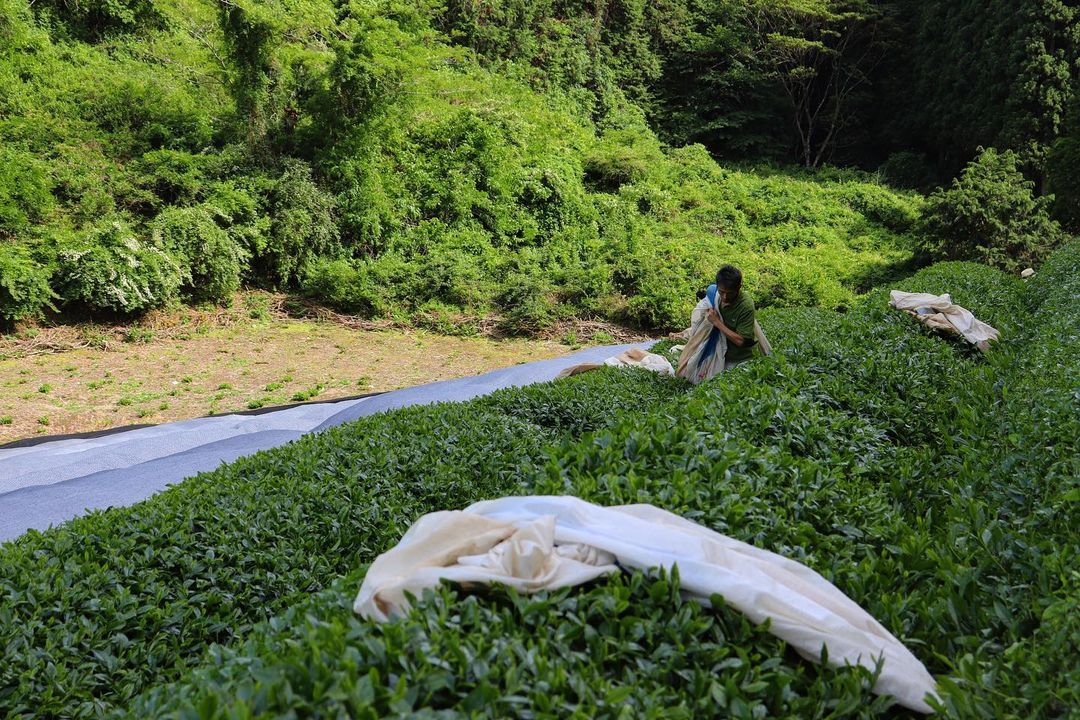Hello! Genki-desuka (元気ですか?How are you, in Japanese)?
Especially during these strange times, we hope that you are finding moments in your day to enjoy a warm cup of tea. Today, we are back to talk about one of the major tea producing regions in the Kyoto region. We will be touching on Ujitawara, a heart-shaped town located southeast of Kyoto and Uji cities. Ujitawara is thought to be the birthplace of Japanese green tea and one of the chief tea producing regions for Uji-cha. Hmm, but if you have been following us with the major tea producing regions in Japan blog posts, you might say, “But I thought Ureshino in Kyushu was the birthplace of Japanese tea? Well, get ready to find out more and dive into some Japanese tea history!
History of Tea Cultivation in Ujitawara
As we covered a bit in our post on Uji, tea cultivation in Ujitawara began in the Kamakura Period (1185-1333). It is said that the disciple of a noted priest, Myoe Shounin of Kozanji Temple, obtained seeds from the Zen Buddhist monk Eisai, who is famous for bringing tea seeds back to Kyoto from a trip to China in the late 12th century. Myoe therefore introduced the tea cultivation method in the Kamakura Period and planted seeds in various places around the Uji and Kyoto regions. The very first tea seeds were said to have been planted in the interior of Obukudani area located at the foot of the sacred Mt. Jubu (Jubusan), located in Ujitawara. Many streams flow from the deep valley of the sacred mountain, Mt.Jubu. One of them is Otaki Waterfalls in Yuyudani, which also enshrines a water deity. In this region, on September 1st, a ritual called Otaki Daimyojin Festival is held to pray for good rains and bountiful harvest. Legend says that tea cultivated at Obukudani became very popular and was praised by the Shogunate and Imperial House for having the deepest aroma.
 Tea fields in the famous Obukudani area in Ujitawara, photo by Nagatani Tea Factory
Tea fields in the famous Obukudani area in Ujitawara, photo by Nagatani Tea Factory
Soen Nagatani, the father of Japanese sencha
Later, during the Edo Period (range 1603 - 1868) Soen Nagatani (1681 - 1778), a farmer from Yuyutani Village, Ujitawarago, Yamashiro Province (present day Yuyutani district, Ujitwara-Cho, Tsuzuki-gun, Kyoto prefecture), developed an innovative tea manufacturing method unique to Japan, that would revolutionize Japanese tea.
In the year 1738, Soen Nagatani, after having spent 15 years experimenting with existing tea manufacturing methods, such as the kamairi roasting method and the tencha manufacturing method, presented a new tea processing method. In the new method, freshly picked tea leaves were steamed and then laboriously and skillfully hand-kneaded over a specially constructed hoiro table. A hoiro is a sturdy table covered with washi, traditional Japanese paper, that when treated with persimmon juice becomes elastic and durable. Inside the table was an alcove where warm coals were placed to maintain the washi paper at the ideal temperature, which is approximately body temperature [1]. The result was a sencha permeated with a refreshing green color, aroma, and flavor. Soen’s success is acclaimed to have been groundbreaking as it changed the relatively crude brown tea (bancha) that common people used to drink into a more accessible, delicious green tea. Today, sencha is most commonly consumed in Japan.
Perhaps, more importantly however, he travelled to Edo (present day Tokyo) and sold the green tea through the sales channel of a tea dealer, Kahei Yamamoto, who later opened the renowned Yamamotoyama Store. This marked the start to a long relationship between the Nagatani and Yamamoto families. Soen’s tea was quickly heralded as the “Best in Japan” and became quite successful. From this time, the senjicha (煎じ茶) method of boiling tea leaves was eclipsed by the dashicha (だし茶) way of making tea, in which tea leaves were put into a tea pot and then steeped in hot water.
 Photo taken by Nagatani Tea Factory in Ujitawara
Photo taken by Nagatani Tea Factory in Ujitawara
This tea manufacturing method introduced by Soen Nagatani is known as “Aosei Sencha Seiho (steam processing green tea method)” and serves as the foundation of modern Japanese green tea. Later, in 1835 one of the origin stories of gyokuro states that the 6th generation descent of Kahei Yamamoto (meaning tea dealer of Yamamotoyama) realized that shaded tea presents more umami and adapted the steaming and rolling methods to produce what we now know as gyokuro. Together, the tea manufacturing methods of sencha and gyokuro have been referred to as the Uji-cha tea processing methods and quickly spread throughout Japan [2].
During the Edo period, tea was made by those whose profession was called a “tea master” (茶師; chashi), and tea was made through a process of hand kneading as in Soen’s Aosei Sencha Seiho method. In the Meji era, due to increased demands for tea, tea manufacturing machines were invented and developed. Through continuous improvement, today, most teas are made by machines. Still, the foundation for these machines lies in the process of hand kneading. Soen’s hand kneading technique is still practiced today, as a way to preserve tradition, and there are even hand rolling competitions! If you ever have an opportunity to taste hand kneaded tea or even better - to observe a tea hand kneading demonstration, it will definitely be worthwhile to sense the passion of the people putting energy into the tea over the long kneading process [3]!

Photo of the hand kneading process today taken by Nishide Tea Factory
Although it is true that the Uji-district and many tea history books recognize Soen Nagatani to be the sole inventor of this steaming method for producing sencha, it is important to note that by the late 16th century, tea was produced through diverse methods all throughout Japan. Hence, it is quite likely that numerous tea farmers and merchants were concurrently experimenting with leaves being steamed or boiled, then dried with sunlight, or utilizing a hoiro, although in the early modern times, the crumpling process was added. In sum, the method for producing tea has been continuously improved and perhaps it should not be attributed to the work of a single person.
Bringing Ujitawara Tea to Edo, Building a Tea Community
While it is highly likely that Soen Nagatani was not the sole inventor for the “Aoseisencha Seiho” method of producing tea, he does deserve to be recognized as the father and creator of Japanese sencha. This is because Soen pioneered the direct sales route for Ujitawara tea to Edo (i.e., the current Tokyo). That is, he helped bring Uji tea to the principal population of consumers at that time, which helped to establish the foundation of nationwide sales and networking for tea. Further, it is said that Soen had no reservations of teaching and sharing this method of Aoiseisencha Seiho to those who visited his place. Thus, people from all over Japan came to learn this new method for making tea.
In fact, because of the popularity of Soen’s sencha in the Edo era, the district of Yuyadani (in Ujitawara) started to grow and thrive as a community of sencha growers and wholesalers. Although Yuyudani is situated in quite a steep valley, the area became vibrant with large tea wholesale stores and was populated by tea farmers. Soen Nagatani’s birthplace (located in Yuyudani) has since been restored and recognized as a National Heritage, site along with Yuyudani’s streetscapes, tea plantations, and tea farmers (April 2015). If you are keen about Japanese tea and history, Ujitawara is definitely worth a visit, especially as Soen’s home is open for viewing to the public and one may even see the hoiro that Soen is said to have used!
Discover Tea from Ujitawara at Yunomi:
Now that you have learned a bit more about the history of Ujitawara and tea manufacturing, you may appreciate teas from this region of Japan even more! Here are a couple of the fine tea factories from this renowned region:
- Nishide Tea Factory: Established over 140 years ago, this tea factory is managed by husband and wife Takashi and Atsuko NIshide and their family. The Nishide folks purchase aracha (unrefined tea leaves) from the tea farms of Kyoto and surrounding prefectures, then refines them further to craft high quality tea leaves that are uniform in color and shape, and of course excellent in flavor!
- Nagatani Tea Factory: The Nagatani family has been based in Ujitawara for over 120 years. They have tea fields throughout the Ujitawara region, including in the famous Ohbukudani area where Myoen is to have planted one of the very first tea seeds in Kyoto. The Nagatani family have their own tea processing factory where they process high quality Uji-cha. You can catch beautiful photos from their tea work through their Instagram page.

Snake on top of the tea fields of Obukutani, photo by Nagatani Tea Factory
References
- Japanese Tea Processing. Global Japanese Tea Association: https://gjtea.org/info/japanese-tea-information/japanese-tea-processing/
- NPO Nihoncha Instructor Association (2008). Nihoncha-no-subete-ga- wakaru-hon. Understanding Everything About Japanese Tea. Tokyo, Japan.
- Tamura, H. June, 2018. Sencha-no-seizou-ha-temomi-ga-kihon. The foundation of sencha processing is in hand kneading. Retrieved from: http://www.naro.affrc.go.jp/publicity_report/publication/files/Fruit_Tea_Times_No8.pdf
Banner image credit: Nagatani Tea Factory; tea fields in Obukudani, Ujitawara, Japan.


